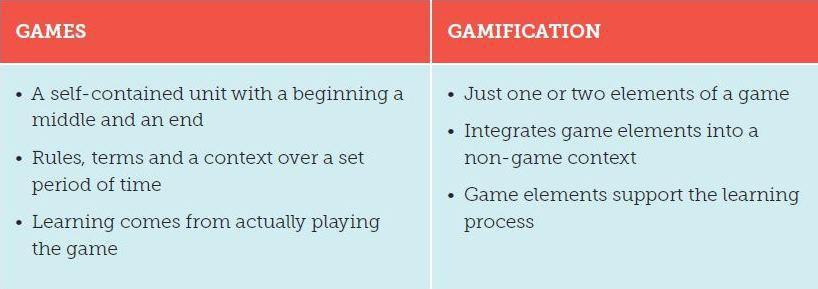Elearning games for adults come in all shapes and sizes and they can deliver different benefits in terms of learning and skills development. But what are the different types of elearning games and how do they fit into workplace training?
Defining elearning games for adults is proving tricky for the Learning and Development (L&D) world.
First of all, we are still struggling with the definition of gamification in learning after years of discussion on the subject. Thankfully, Professor Karl M. Kapp has done a pretty good job of pinning it down in his recent blog post, An Elusive Definition.
Secondly, there is a hang up about the difference between gamification and elearning games for adults. This useful graphic helps to compare some of the characteristics.

Pinning down these definitions can be helpful to aid our understanding of gamification in learning and games for e-learning, but dwelling on them can be counterproductive. Pigeonholing elearning games for adults as a specific genre risks overlooking one of their key benefits within learning – their broad range and scope.
So when someone asks to see a typical elearning game, it is very difficult to represent what is possible with a single example. Instead, we’ve picked out six types of best elearning games - these are particularly useful for workplace learning.
Elearning game types
Role-playing games

In this type of game learners take on the role of a character, usually the protagonist. The character might be represented as an avatar or the game may be constructed from the learner’s point of view (PoV). The game has a strong narrative and the learner must complete tasks or make decision in the role of the character. Role-playing elearning games are useful in the workplace to support customer service, soft skills training or empathy development.
Timed games

Working against the clock adds to the challenge and some elearning games are specifically designed to make the most of the time element. Playing against a timer can stretch learners and adds a new dimension to learning tasks. Timed games for elearning work well in compliance training to boost engagement or where employees have to make quick decisions.
Decision games

As another one of game examples for elearning, these require learners to make a set of decisions to move through the game. There may be an optimum set of options but there can also be ambiguity with no perfect decision possible. Often, learners will be able to replay and see what would happen if they made a different decisions. Again, a strong narrative is important. Decision games lend themselves well to leadership training and other soft skills development.
Collaborative games

People often focus on the competitive aspect of elearning games but they can be just as powerful as team exercises. Collaborative games may require learners to work together to complete a complex challenge or allow a single player to seek outside help to finish a game task. In the workplace, collaborative games for elearning can help support team skills or act as an ice-breaker in an induction programme.
Detective games

Exploring the game space and trying to solve a mystery, puzzle or challenge is the key characteristic of the detective type of elearning game. It hinges on the learner being curious and a narrative works well in this kind of elearning game. They are useful in helping to develop the problem-solving skills of employees, as well as a good way to teach aspects of compliance where observation is important.
Competitive games

Competing against individuals or teams not only motivates learners but can help their development by allowing them to compare their performance against others. Competitive elearning games for adults may allow learners to check their score against colleagues in the form of a leader board or similar system. They can be useful in situations where workplace learning needs to be completed within a tight deadline or as part of a team-building challenge.
So, in summary, here are six elearning games examples you might consider using as part of a workplace training programme:
- Role-play games - Where learners must take on the role of a character in the game.
- Timed games – Where learners must work against the clock to complete a challenge.
- Decision games – Where learners must choose the ‘best’ course of action or decide how to respond to a given situation.
- Collaborative games – Where learners must work in teams to solve a problem or complete a challenge with help from others.
- Detective games – Where learners must explore the game trying to solve a mystery, puzzle or challenge.
- Competitive games – Where learners must compete as individuals, or in teams, to score points and win the game.
Of course, this is just a selection and by no means an exhaustive list. It’s also worth remembering that some elearning games combine several different types; there are no hard and fast rules.
By embracing the variety, rather than worrying about definitions, we are more likely to use elearning games creatively and focus on what really matters – how they can aid workplace learning and development.
